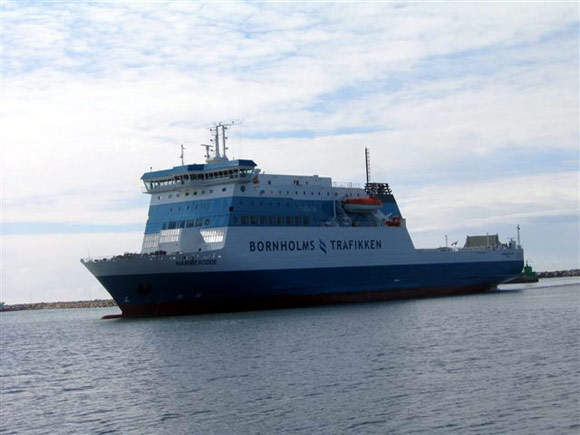The Hammerodde and Dueodde RoPax ferries were built by the Dutch shipyard Merwede for Bornsholm Trafikken. They will work on the route between the island of Bornholm, Koge, the Danish port near Copenhagen, and the Swedish port of Ystad. They were built in a constrained time frame of 11 months to act as freight-only or car / passenger ferries.
The vessels have an overall length of 124.9m or 115.1m between perpendiculars, and a 23.4m moulded breadth. They have a design draught of 5.3m and a deadweight (at design draught) of 2,883t. They register a gross tonnage of 13,906t.
VEHICLE CAPACITY
The vehicles are accommodated across two decks in a total lane length of 1,248m, distributed across seven lanes, 3.1m in width. This corresponds to around 92 trucks or a mixture of cars and trailers. The vehicles are stored in decks 3 and 5, with 4.9m and 5.2m clearance heights respectively. Deck 3 has a lane length of 645m. These decks contain reefer plugs.
PASSENGER ACCOMMODATION
The ferries can accommodate 400 passengers. These can be housed in 20 one-berth cabins, 36 two-berth cabins or four four-berth cabins. There are also 256 reclining seats.
Deck 7 contains a cafeteria area with 50 seats as well as a reception area, shops, toilets and a children’s area. There is a viewing lounge with 91 seats, a non-smoking lounge with 57 seats, a smoking lounge with 30 seats, an allergy lounge with 48 seats and a pet lounge with 30 seats. The owner’s have included in the design the potential to expand the accommodation to 770 passengers.
PROPULSION AND MANOEUVRING
Power is provided by a pair of MaK 9M32 medium-speed diesel engines, each with an output of 4,320kW at 600rpm They are connected to a Jahnel reduction gearbox and to a controllable pitch propeller. This gives a service speed of around 18.8 knots at a 90% MCR.
The vessels have two Alfa Laval heavy fuel oil treatment system , a self-cleaning diesel oil separator and a bilge water separator.
Steering is carried out by a pair of Tenfjorfd electro-hydraulic gear, each connected to a Rolls Royce rudder. The rudders have a 45° deflection to both sides. It takes 14 seconds to turn them 65°, or 28 seconds with one pump being used. The vessel ride is controlled by a set of Fincantieri fin-type stabilisers. These are designed to reduce roll to 90% at a wave slope of 3.5° and at a speed greater than 18 knots.
When manoeuvring in port, a bow thruster is used. This is powered by two auxiliary alternators.
VESSEL SYSTEMS
The electrical installation was carried out by Croon TBI technik.
The ships’ electric power is provided by three MAN Holeby 6L 16/24 gensets. These can develop a total of 1,545kW of power. The vessels’ emergency power is provided by a 260kW Man D2866 LXE201 genset. There is also a 1,160kW PTO alternator which can be employed to generate power at sea.
The fire fighting facilities include a seawater-based fire system and a CO2 flooding system for the engine room and galley. The emergency equipment includes two 150-person lifeboats, seven 35-person inflatable rafts and two fast-rescue boats. The liferafts are supplied by Viking.
Central heating is carried out by means of a heat exchanger from the thermal oil system, in which circulation pumps supply the accommodation heating and domestic hot water.
The vessels are classified by Lloyds under the notation +100A1 RORO Passenger Ship, LMC, UMS.









